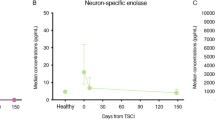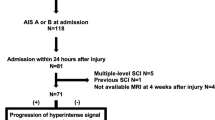Abstract
Background
Spinal cord injury (SCI) can result in lifelong disability. Currently, the literature suggests that biomarkers are helpful in prognosticating SCI, but there is no specific biomarker to date. This is the first study that predicted the prognosis dynamically using biomarkers.
Aim
To elucidate the role of biomarkers in prognosticating acute traumatic SCI.
Methods
Blood samples were obtained from 35 patients of acute traumatic SCI at presentation, immediate post-op, and at 6 weeks. At 6 months follow-up, patients were divided into two groups, i.e, improved and non-improved based on the improvement in the ASIA grade compared to presentation. A non-parametric test was used for comparing mean NSE, MMP-2, S100-B, and NF serum levels at presentation, immediate post-op, and 6 weeks post-op follow-up between the two groups.
Results
There was a significant difference (p = 0.03) in the NF values at presentation between the two groups. The difference of NSE values at 6 weeks was also significant (p = 0.016) between the two groups. S-100B levels were also significantly different between both groups at presentation (p=0.016), and at the immediate post-op stage (p=0.007). MMP-2 levels neither displayed any specific trend nor any significant difference between the two groups.
Conclusion
Higher NF values at presentation, and higher S-100B levels at presentation and immediate post-operative period correlated with poor outcome. Also, increased NSE values after surgery are indicative of no improvement. These levels can be used at various stages to predict the prognosis. However, further studies are required on this topic extensively to know the exact cut-off values of these markers to predict the prognosis accurately.
Clinical trials registry number
REF/2020/01/030616
Similar content being viewed by others
References
Tator CH (1995) Update on the pathophysiology and pathology of acute spinal cord injury. Brain Pathol 5(4):407–13. https://doi.org/10.1111/j.1750-3639.1995.tb00619.x. (PMID: 8974623)
McDonald JW, Sadowsky C (2002) Spinal-cord injury. Lancet 359(9304):417–25. https://doi.org/10.1016/S0140-6736(02)07603-1. (PMID: 11844532)
Ackery A, Tator C, Krassioukov A (2004) A global perspective on spinal cord injury epidemiology. J Neurotrauma 21(10):1355–70. https://doi.org/10.1089/neu.2004.21.1355. (PMID: 15672627)
Missler U, Wiesmann M, Ehlermann P et al (2000) Validation and comparison of two solid-phase immunoassays for the quantification of S-100B in human blood. Clin Chem 46(7):993–6 (PMID: 10894844)
Leviton A, Dammann O (2002) Brain damage markers in children. Neurobiological and clinical aspects. Acta Paediatr 91(1):9–13. https://doi.org/10.1080/080352502753457851. (PMID: 11883827)
Slemmer JE, Matser EJ, De Zeeuw CI et al (2002) Repeated mild injury causes cumulative damage to hippocampal cells. Brain 125(Pt 12):2699–709. https://doi.org/10.1093/brain/awf271. (PMID: 12429597)
Willoughby KA, Kleindienst A, Müller C et al (2004) S100B protein is released by in vitro trauma and reduces delayed neuronal injury. J Neurochem 91(6):1284–91. https://doi.org/10.1111/j.1471-4159.2004.02812.x. (PMID: 15584905)
Hayakawa K, Okazaki R, Ishii K et al (2012) Phosphorylated neurofilament subunit NF-H as a biomarker for evaluating the severity of spinal cord injury patients, a pilot study. Spinal Cord 50(7):493–6. https://doi.org/10.1038/sc.2011.184. (Epub 2012 Jan 24 PMID: 22270191)
Lewis SB, Wolper RA, Miralia L et al (2008) Detection of phosphorylated NF-H in the cerebrospinal fluid and blood of aneurysmal subarachnoid hemorrhage patients. J Cereb Blood Flow Metab 28(6):1261-71. https://doi.org/10.1038/jcbfm.2008.12. Epub 2008 Mar 5. Erratum in: J Cereb Blood Flow Metab 28(6):1274. PMID: 18319731
Zurek J, Bartlová L, Fedora M (2011) Hyperphosphorylated neurofilament NF-H as a predictor of mortality after brain injury in children. Brain Inj. 25(2):221–6. https://doi.org/10.3109/02699052.2010.541895. (PMID: 21219092)
Page-McCaw A, Ewald AJ, Werb Z (2007) Matrix metalloproteinases and the regulation of tissue remodelling. Nat Rev Mol Cell Biol 8(3):221–33. https://doi.org/10.1038/nrm2125.PMID:17318226;PMCID:PMC2760082
Detloff MR, Fisher LC, McGaughy V et al (2008) Remote activation of microglia and pro-inflammatory cytokines predict the onset and severity of below-level neuropathic pain after spinal cord injury in rats. Exp Neurol 212(2):337-47. https://doi.org/10.1016/j.expneurol.2008.04.009. Epub 2008 Apr 20. PMID: 18511041; PMCID: PMC2600773
Yong VW (2005) Metalloproteinases: mediators of pathology and regeneration in the CNS. Nat Rev Neurosci 6(12):931–44. https://doi.org/10.1038/nrn1807. (PMID: 16288297)
Werb Z (1997) ECM and cell surface proteolysis: regulating cellular ecology. Cell 91(4):439–42. https://doi.org/10.1016/s0092-8674(00)80429-8. (PMID: 9390552)
Goussev S, Hsu JYC, Lin Y et al (2003) Differential temporal expression of matrix metalloproteinases after spinal cord injury: relationship to revascularization and wound healing. J Neurosurg: Spine 99(2):188–197
Yang J, Wang G, Gao C et al (2013) Effects of hyperbaric oxygen on MMP-2 and MMP-9 expression and spinal cord edema after spinal cord injury. Life Sci 93(25–26):1033–8 (PMID: 24436993)
Kirshblum SC, Burns SP, Biering-Sorensen F et al (2011) International standards for neurological classification of spinal cord injury (revised 2011). J Spinal Cord Med 34(6):535–46. https://doi.org/10.1179/204577211X13207446293695. (PMID:22330108;PMCID:PMC3232636)
Lee SJ, Kim CW, Lee KJ et al (2010) Elevated serum S100B levels in acute spinal fracture without head injury. Emerg Med J 27(3):209–12. https://doi.org/10.1136/emj.2008.063743. (PMID: 20304889)
Kwon BK, Stammers AM, Belanger LM et al (2010) Cerebrospinal fluid inflammatory cytokines and biomarkers of injury severity in acute human spinal cord injury. J Neurotrauma 27(4):669–82. https://doi.org/10.1089/neu.2009.1080. (PMID: 20038240)
Wolf H, Krall C, Pajenda G et al (2014) Alterations of the biomarker S-100B and NSE in patients with acute vertebral spine fractures. Spine J 14(12):2918–22. https://doi.org/10.1016/j.spinee.2014.04.027. (Epub 2014 Apr 26 PMID: 24780247)
Pouw MH, Kwon BK, Verbeek MM et al (2014) Structural biomarkers in the cerebrospinal fluid within 24 h after a traumatic spinal cord injury: a descriptive analysis of 16 subjects. Spinal Cord. 52(6):428–33. https://doi.org/10.1038/sc.2014.26. (Epub 2014 Apr 8 PMID: 24710150)
Ahadi R, Khodagholi F, Daneshi A et al (2015) Diagnostic Value of Serum Levels of GFAP, pNF-H, and NSE Compared With Clinical Findings in Severity Assessment of Human Traumatic Spinal Cord Injury. Spine (Phila Pa 1976) 40(14):E823-30. https://doi.org/10.1097/BRS.0000000000000654. (PMID: 25341992)
Du W, Li H, Sun J et al (2018) The Prognostic Value of Serum Neuron Specific Enolase (NSE) and S100B Level in Patients of Acute Spinal Cord Injury. Med Sci Monit 30(24):4510–4515. https://doi.org/10.12659/MSM.907406. (PMID:29959890;PMCID:PMC6057265)
Ungureanu D, Iencean ŞM, Dimitriu C et al (2014) Determination of the phosphorylated neurofilament subunit NF-H (pNF-H) in cerebro-spinal fluid as biomarker in acute traumatic spinal cord injuries/Dozarea neurofilamentelor fosforilate (subunitatea pNF-H) ȋn LCR ca biomarker ȋn traumatismul vertebro-medular acut. Revista Romana de Medicina de Laborator 22(3):377–86
Kuhle J, Gaiottino J, Leppert D et al (2015) Serum neurofilament light chain is a biomarker of human spinal cord injury severity and outcome. J Neurol Neurosurg Psych 86(3):273–9. https://doi.org/10.1136/jnnp-2013-307454. (Epub 2014 Jun 16 PMID: 24935984)
Noble LJ, Donovan F, Igarashi T et al (2002) Matrix metalloproteinases limit functional recovery after spinal cord injury by modulation of early vascular events. J Neurosci. 22(17):7526–35. https://doi.org/10.1523/JNEUROSCI.22-17-07526.2002. (PMID:12196576;PMCID:PMC2792199)
Buss A, Pech K, Kakulas BA et al (2007) Matrix metalloproteinases and their inhibitors in human traumatic spinal cord injury. BMC Neurol 26(7):17. https://doi.org/10.1186/1471-2377-7-17. (PMID:17594482;PMCID:PMC1914362)
Dang AB, Tay BK, Kim HT et al (2008) Inhibition of MMP2/MMP9 after spinal cord trauma reduces apoptosis. Spine (Phila Pa 1976). 33(17):E576–9. https://doi.org/10.1097/BRS.0b013e31817ecc87. (PMID: 18670324)
Zhang H, Chang M, Hansen CN et al (2011) Role of matrix metalloproteinases and therapeutic benefits of their inhibition in spinal cord injury. Neurotherapeutics. 8(2):206–20. https://doi.org/10.1007/s13311-011-0038-0. (PMID:21455784;PMCID:PMC3077748)
Acknowledgements
This research study was funded by AO Trauma Asia Pacific with a research grant of 3000 CHF and by an intramural research grant of 5 lacs from PGIMER, Chandigarh, India.
Author information
Authors and Affiliations
Corresponding author
Ethics declarations
Ethical approval
This study was approved by the Institutional Ethics Committee of PGIMER, Chandigarh vide letter no. INT/IEC/2019/002793 in their meeting held on 12/09/2018. The study was performed in accordance with the ethical standards as laid down in the 1964 Declaration of Helsinki and its later amendments or comparable ethical standards.
Consent to publish
Patients signed informed consent regarding publishing their data.
Consent to participate
Informed consent was obtained from all individual participants included in the study and in case it was not possible to take direct consent from the participant, informed consent was obtained from the legal guardians.
Conflict of interest
The authors declare that they have no conflict of interest.
Additional information
Publisher's Note
Springer Nature remains neutral with regard to jurisdictional claims in published maps and institutional affiliations.
Rights and permissions
Springer Nature or its licensor (e.g. a society or other partner) holds exclusive rights to this article under a publishing agreement with the author(s) or other rightsholder(s); author self-archiving of the accepted manuscript version of this article is solely governed by the terms of such publishing agreement and applicable law.
About this article
Cite this article
Paragond, S., Dhatt, S.S., Kumar, V. et al. Prognosticating acute traumatic spinal cord injury using Neurofilament (NF), Neuron Specific Enolase (NSE), Matrix Metalloproteinases (MMPs), and S-100B as biomarkers. Ir J Med Sci 193, 769–775 (2024). https://doi.org/10.1007/s11845-023-03476-6
Received:
Accepted:
Published:
Issue Date:
DOI: https://doi.org/10.1007/s11845-023-03476-6




